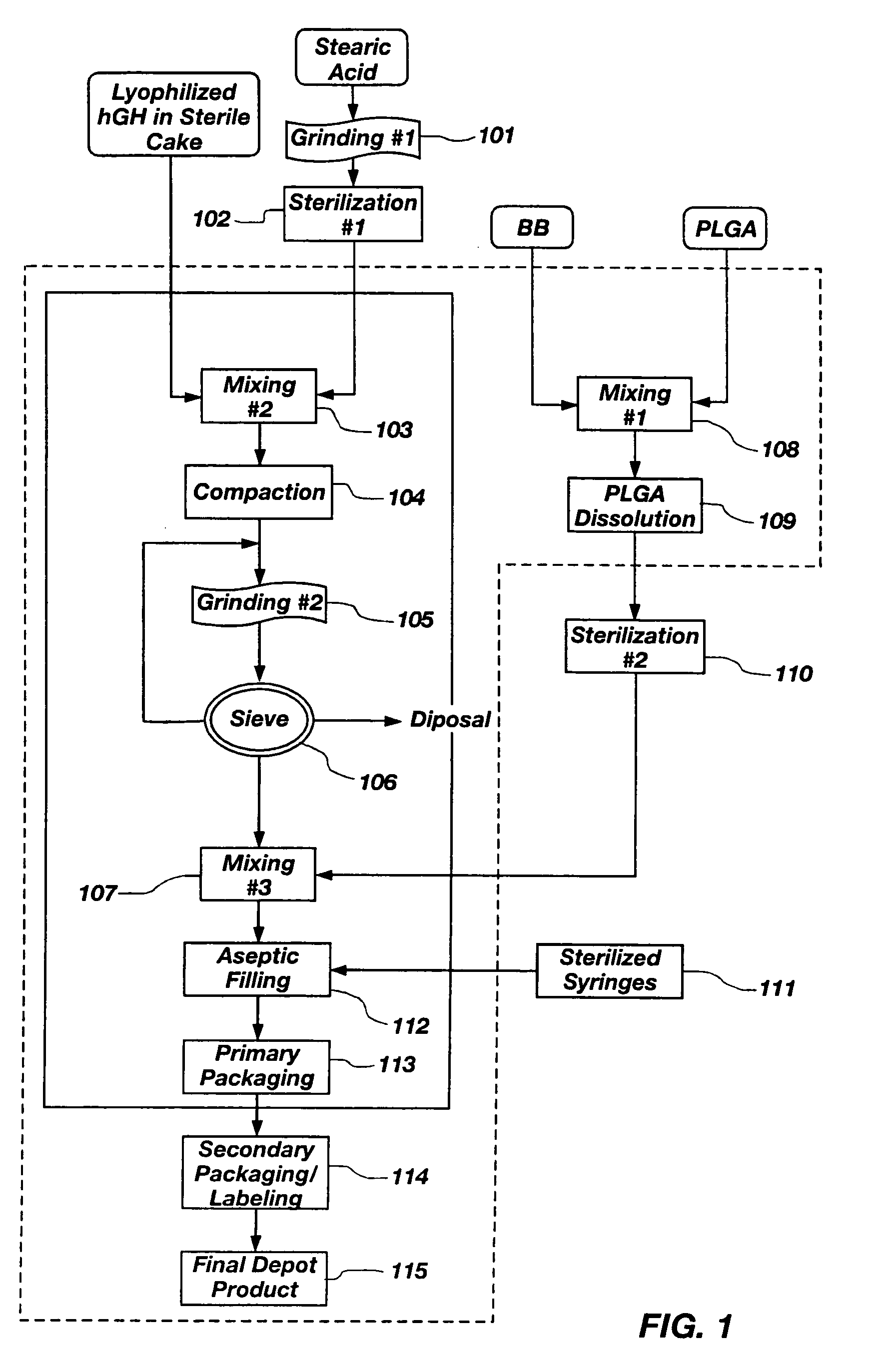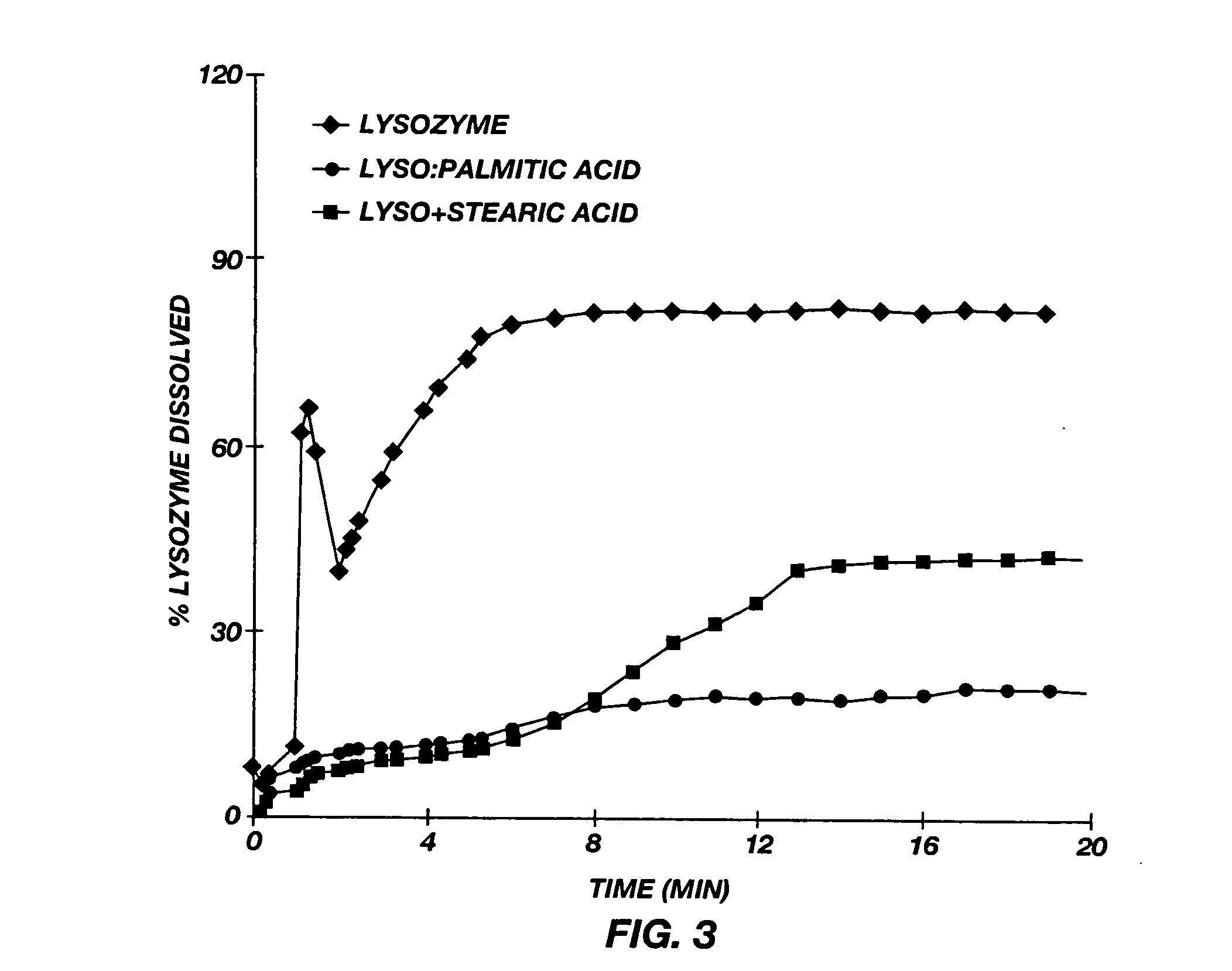Implantable gel compositions and method of manufacture
a gel composition and gel technology, applied in the field of implantable compositions, can solve the problem of too much active agent releas
- Summary
- Abstract
- Description
- Claims
- Application Information
AI Technical Summary
Benefits of technology
Problems solved by technology
Method used
Image
Examples
example 1
Gel Vehicle Preparation
[0117] A glass vessel is tared on a Mettler PJ3000 top loader balance. Poly (D,L-lactide-co-glycolide) 50:50 RESOMER® RG502 (PLGA-502) is weighed into the glass vessel. The glass vessel containing PLGA-502 is tared and the corresponding solvent is added. Amounts expressed as percentages for various polymer / solvent combinations are set forth in Table 1 below. The polymer / solvent mixture is manually stirred with a stainless steel square-tip spatula, resulting in a sticky amber paste-like substance containing white polymer particles. The vessel containing the polymer / solvent mixture is sealed and placed in a temperature controlled incubator equilibrated to 37° C.-39° C. The polymer / solvent mixture is removed from the incubator when it appears to be a clear amber homogeneous gel. Incubation time intervals may range from 1 to 4 days, depending on solvent and polymer type and solvent and polymer ratios. Additional depot gel vehicles are prepared with the following ...
example 2
hGH Particle Preparation
[0118] Human growth hormone (hGH) particles (optionally containing zinc acetate) were prepared as follows:
[0119] hGH solution (5 mg / ml) solution in water (BresaGen Corporation, Adelaide, Australia) is concentrated to 10 mg / mL using a Concentration / Dialysis Selector diafiltering apparatus. The diafiltered hGH solution is then washed with 5 times volume of tris or phosphate buffer solution (pH 7.6). Particles of hGH are then formed by spray drying or lyophilization using conventional techniques. Phosphate buffer solutions (5 or 50 mM) containing hGH (5 mg / mL) (and optionally various levels of zinc acetate (0 to 30 mM) when Zn complexed particles are prepared) are spray-dried using a Yamato Mini Spray dryer set at the following parameters:
Spray Dryer ParameterSettingAtomizing Air2 psiInlet Temperature120° C.Aspirator Dial7.5Solution Pump2-4Main Air Valve40-45 psi
[0120] hGH particles having a size range between 2-100 microns are obtained. Lyophilized particle...
example 3
[0121] Lysozyme particles are prepared by spray drying 50% sucrose and 50% chicken lysozyme (on a dry weight basis) using the procedure described in Example 2. Those particles are mixed with stearic acid, palmitic acid, and myristic acid, respectively, in the manner described above to produce compressed particulates comprising a mixture of lysozyme and the corresponding fatty acid having particle sizes between about 40 μm and 200 μm. Two stearic acid batches had mean particles sizes of 65 μm and 85 μm, respectively; two palmitic acid batches had mean particle sizes of 80 μm and 76 μm, respectively; and a myrstic acid batch had a mean particle size of 74 μm.
TABLE 1Gel VehiclesSolvent / AmountAmountGelPolymerSolventPolymerSolventPolymerWeightRatio50 / 50BBPLGA-5025 g5 g10 g1.050 / 50TA / BBPLGA-5025 g5 g10 g1.0Mixture60 / 40TA / BBPLGA-5026 g4 g10 g1.5Mixture70 / 30TA / BBPLGA-5027 g3 g10 g2.3Mixture80 / 20TA / BBPLGA-5028 g2 g10 g4.0Mixture50 / 50EBPLGA-5025 g5 g10 g1.050 / 50TA / EBPLGA-5025 g5 g10 g1.0Mix...
PUM
| Property | Measurement | Unit |
|---|---|---|
| mean particle size | aaaaa | aaaaa |
| size | aaaaa | aaaaa |
| size | aaaaa | aaaaa |
Abstract
Description
Claims
Application Information
 Login to View More
Login to View More - R&D
- Intellectual Property
- Life Sciences
- Materials
- Tech Scout
- Unparalleled Data Quality
- Higher Quality Content
- 60% Fewer Hallucinations
Browse by: Latest US Patents, China's latest patents, Technical Efficacy Thesaurus, Application Domain, Technology Topic, Popular Technical Reports.
© 2025 PatSnap. All rights reserved.Legal|Privacy policy|Modern Slavery Act Transparency Statement|Sitemap|About US| Contact US: help@patsnap.com



